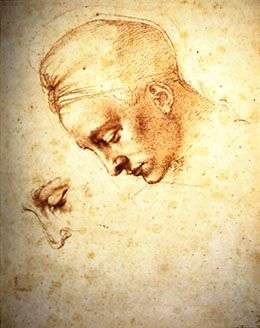Leda And The Swan (Michelangelo) on:
[Wikipedia]
[Google]
[Amazon]
''Leda and the Swan'' is a lost tempera on canvas painting by
 In 1512, Alfonso I d'Este, Duke of Ferrara went to Rome to reconcile with Pope Julius II, who had excommunicated him in the summer of 1510 for his alliance with
In 1512, Alfonso I d'Este, Duke of Ferrara went to Rome to reconcile with Pope Julius II, who had excommunicated him in the summer of 1510 for his alliance with
Michelangelo
Michelangelo di Lodovico Buonarroti Simoni (; 6 March 1475 – 18 February 1564), known as Michelangelo (), was an Italian sculptor, painter, architect, and poet of the High Renaissance. Born in the Republic of Florence, his work was insp ...
, produced in 1530, but now only surviving in copies and variants. The work depicted the Greek myth of Leda and the Swan
Leda and the Swan is a story and subject in art from Greek mythology in which the god Zeus, in the form of a swan, seduces or rapes Leda. According to later Greek mythology, Leda bore Helen and Polydeuces, children of Zeus, while at the sa ...
.
History
 In 1512, Alfonso I d'Este, Duke of Ferrara went to Rome to reconcile with Pope Julius II, who had excommunicated him in the summer of 1510 for his alliance with
In 1512, Alfonso I d'Este, Duke of Ferrara went to Rome to reconcile with Pope Julius II, who had excommunicated him in the summer of 1510 for his alliance with Louis XII of France
Louis XII (27 June 14621 January 1515), was King of France from 1498 to 1515 and King of Naples from 1501 to 1504. The son of Charles, Duke of Orléans, and Maria of Cleves, he succeeded his 2nd cousin once removed and brother in law at the tim ...
against the Republic of Venice. Julius absolved him and Alfonso spent a few days in Rome before returning to Ferrara. On 11 July, he visited the Sistine Chapel, where Michelangelo was completing the ceiling
A ceiling is an overhead interior surface that covers the upper limits of a room. It is not generally considered a structural element, but a finished surface concealing the underside of the roof structure or the floor of a story above. Ceilings ...
. He climbed the scaffolding and had a long and admiring conversation with Michelangelo, who promised him a painting.
Several years passed without the commission being formalised until Michelangelo had to be in Ferrara in 1529 to inspect its city walls as "governor general of fortifications" for the Florentine Republic, ready for an expected Imperial siege. On that occasion the Duke held Michelangelo to his promise and, according to Condivi and Vasari, he produced the work when he returned to Florence in August 1530, after the city's fall, perhaps using the time he had to spend in hiding. It was a square work in tempera, representing Jupiter as a swan making love to a reclining Leda
Leda may refer to:
Mythology
* Leda (mythology), queen of Sparta and mother of Helen of Troy in Greek mythology
Places
* Leda, Western Australia, a suburb of Perth, Western Australia
* Leda makeshift settlement, Bangladesh, a refugee camp ...
(based on a composition from ancient Roman gems and seals), an egg, and Castor and Pollux as children.
The painting was completed by mid-October 1530, but Alfonso described it as a "little thing" in Michelangelo's hearing and so he refused to hand it over. The work and some of the preparatory drawings were acquired later (either as a purchase or a gift) by Antonio Mini, who took it to France in 1531. In 1532, he left the painting to Francis I of France, who later sent it to the Palace of Fontainebleau.
The best known copy of the painting was once attributed to Rosso Fiorentino and is in the National Gallery in London, with others in the Gemäldegalerie (Dresden), the Gemäldegalerie (Berlin), and the Correr Museum in Venice. The Casa Buonarroti in Florence holds not only a copy, but also a preparatory drawing of studies for Leda's head, held to be drawn by Michelangelo. There are several prints copying the work, the most faithful of which is thought to be the one by Nicolas Béatrizet, which also shows Castor and Pollux.
See also
* List of works by MichelangeloReferences
Further reading
* Ettore Camesasca, ''Michelangelo pittore'', Rizzoli, Milano 1966. {{Michelangelo category:Lost paintings category:Mythological paintings by Michelangelo category:1530 paintingsMichelangelo
Michelangelo di Lodovico Buonarroti Simoni (; 6 March 1475 – 18 February 1564), known as Michelangelo (), was an Italian sculptor, painter, architect, and poet of the High Renaissance. Born in the Republic of Florence, his work was insp ...